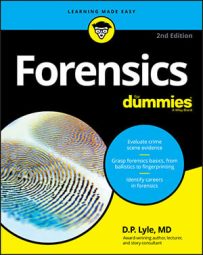When beginning the comparisons between two handwritten documents, an examiner looks for points of similarity and points of difference between the known standards and the questioned document. The examiner typically assesses the following features:
Overall form: The size, shape, slant, proportion, and beginning and ending strokes of the letters are part of the writer's overall form.
Line features: Writing speed, fluidity, and the amount of pen pressure used provide hints about line features, and so do the spacing between letters and words and how the letters are connected.
Margins and format: The width of the margins, the consistency of the spacing, and the slant between lines fit into this category, which covers the overall form and layout of the writing.
Content: Grammar, punctuation, and word choice help point the examiner toward consistent errors, repeated phrases, and other clues that hint at a writer's ethnicity or level of education.
Astute examiners look for all of these features when comparing documents or signatures. No single feature makes an accurate comparison, but a combination of features may enable examiners to determine whether suspect and sample writings came from the same person, which ultimately is a subjective judgment. However, based on the findings, examiners may say that the documents
Absolutely match
Match with a high probability
Probably match
Do not match
Not every examination ends in an answer: The examiner may also say that a determination based on the samples is not possible. That outcome isn't too common, though. If the writing in question is cursive (with the letters joined) or a signature, a trained examiner usually can usually determine whether a particular individual created it. If, however, the questioned document is printed, this task is much more difficult because many of the distinguishing features of cursive writing aren't present in printed text.
Fortunately for law enforcement officials, most criminals aren't that clever, which is something that often becomes evident in written documents, where misspellings are common. Forensic document examiners use these mistakes to their advantage. When suspected writers of forged documents or ransom notes are asked to produce requested samples for comparison, examiners usually ask them to use the same words that were misspelled in the questionable document. More often than not, if a suspect is the author of a questionable document, any misspellings are also seen in the requested writing.
As is true for fingerprints, firearm rifling patterns, and DNA, several handwriting databases exist. The FBI maintains the "National Fraudulent Check File," the "Bank Robbery Note File," and the "Anonymous Letter File." Examiners can compare some questionable documents with these reference files.
High-tech files, like the Forensic Information System for Handwriting (FISH), also exist. FISH contains scanned and digitized documents that officials can compare with other similar documents. Forensic document examiners visually check any matches.

